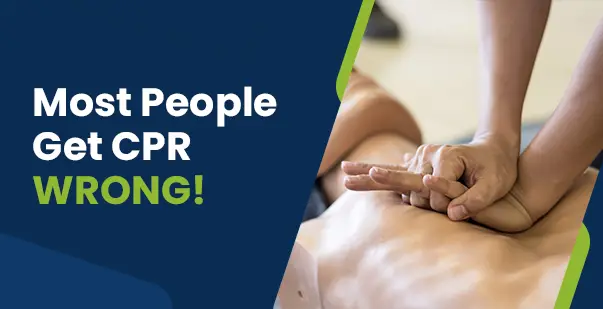Did you know that more than 70% of cardiac arrests happen at home, and nearly half of those cases don’t receive immediate help before emergency services arrive? According to the 2023 American Heart Association (AHA) update, effective chest compressions can triple a person’s chance of survival. Yet, one of the most common mistakes during CPR (Cardiopulmonary Resuscitation) is not pressing deep enough or fast enough. Many people assume they’ll “do CPR right” in the moment, but in high-pressure situations, panic and hesitation take over.
The knowledge of the correct depth of compressions and the ideal rate is not just for healthcare professionals. It’s something everyone should know, whether you’re a trained responder or someone who simply wants to be prepared. So, keep reading to get all the details about ideal depth and compression rates for effective chest compressions.
Master ACLS Now
Get ACLS certified with confidence
Why Are Compression Depth and Rate Important?
CPR manually pumps blood through the heart and into the body, helping to sustain life until professional care arrives. However, compressions that are too shallow may be ineffective, while compressions that are too deep can cause injury.
A recent study by the European Society of Cardiology (ESC) found that bystander-initiated CPR rose sharply, from 26% in 2003–2007 to 69% in 2020–2024. This rise in CPR efforts by the public highlights a growing awareness, but it also puts the spotlight on doing it right. Proper CPR requires:
- The correct depth of compressions to generate effective circulation
- A compression rate that maintains consistent blood flow
- Timely and adequate rescue breaths
Correct Depth of Compressions in CPR Across Age Groups
As of 2025, it has been over 60 years since the American Heart Association (AHA) first published official CPR guidelines in 1966. These guidelines have since been reviewed and updated every five years, with the most recent update released in 2020 and the next anticipated in 2025. Each revision reflects the latest scientific evidence to ensure CPR is performed as effectively as possible.
One of the most common questions people ask is:
“When giving chest compressions, what is the correct compression depth to use?”
The answer varies by age group because the effectiveness of CPR depends on how well we mimic the heart’s pumping action. Let’s understand the right depth of compression to ensure proper blood circulation in different age groups:
Adult CPR: How Deep Should Chest Compressions Be?
According to the American Heart Association (AHA), when performing adult CPR, the depth of compression should be at least 2 inches (approximately 5 cm) but not over 2.4 inches (6 cm). This depth of compression for adults helps to generate enough pressure to ensure proper blood flow during resuscitation.
According to a study published in the journal Resuscitation Plus, pushing too hard during chest compressions (more than 2.4 inches) can cause serious injuries, like broken ribs, in more than 30% of adults. These injuries can make recovery harder.
That is why it is crucial to keep adult CPR depth within the recommended range and at a rate of 100–120 per minute.
Chest Compression Basics for Adult CPR
Place both hands on the lower half of the breastbone. Apply enough pressure to push down, but make sure the chest fully rises back up after each compression. This ensures the heart has time to fill with blood.
Child CPR: What is the Correct Depth of Compressions?
The recommended depth of compressions in adults and children varies due to their size differences. When giving CPR to a child aged 1 to 8 years, the chest compressions should be about 2 inches (5 centimeters) deep, or roughly one-third the depth of the chest. This is because children have smaller, more flexible bodies, and their hearts sit higher in the chest compared to adults.
Chest Compression Basics for Pediatric CPR
Use one or two hands, depending on the child’s size and your strength, and aim for a steady rhythm of 100-120 compressions per minute. Keeping compressions deep enough, fast enough, and with as few interruptions as possible helps keep blood flowing to vital organs, giving the child the best chance of survival.
Infant CPR: What is the Recommended Depth of Compressions in Infants?
For infant CPR, compress the chest about 1.5 inches (4 cm), or one-third of the chest’s depth. Since an infant’s chest is delicate, use two fingers placed just below the nipple line on the breastbone for compressions. If two rescuers are present, the two-thumb method is best, as it applies even pressure and helps maintain steady compressions. The compression rate should be 100 to 120 per minute, with full chest recoil between each compression to ensure blood flow. The goal is to provide enough pressure to circulate blood without causing injury.
Summary Table: Ideal Compression Depth and Rate
The following table provides a quick reference to the recommended depth of compressions and rate for CPR across different age groups.
| Parameters | Adult (Ages 8 and up) | Child (Ages 1–8) | Infant (Under 1 year) |
| Compression Depth | 2–2.5 inches (5–6 cm) | About 2 inches (5 cm) or 1/3 chest diameter | About 1.5 inches (4 cm) or 1/3 chest diameter |
| Compression Rate | 100–120/min | 100–120/min | 100–120/min |
| CPR Ratio | 30:2 | 30:2 (single), 15:2 (two rescuers) | 30:2 (single), 15:2 (two rescuers) |
Read more: When Should Rescuers Switch Positions During CPR
How Does Music Help With Compression Rates?
Music can be a helpful tool to keep the right pace during CPR. Songs like “Stayin’ Alive” by the Bee Gees have a beat that matches the recommended 100–120 compressions per minute. Other songs, like “Another One Bites the Dust” by Queen and “Dancing Queen” by ABBA, also have the right rhythm for CPR. It produces the metronome effect. A metronome is a device that makes a steady sound to help musicians keep a consistent rhythm while playing.
Having music to guide you ensures that your compressions stay steady and effective, which is important for helping the person in need. Moreover, it makes a stressful situation feel easier and boosts your confidence. In an emergency, listening to a familiar song can help you focus and give the person the best chance of survival.
However, music or rhythm tools don’t work the same for everyone. A recent pilot study found that people with a good sense of rhythm, like musicians, are better at keeping the right compression rate. Others may do better with regular training or visual guides. So, while music can help, it’s not the best choice for everyone.
Read more: Why Do Students Need to Be Trained in CPR?
Consistency and Quality: The Pillars of Successful CPR!
Consistency and quality are key to successful CPR, regardless of the person’s age. Quality CPR involves correct depth of compression, rhythm, hand placement, and minimum interruptions. Too shallow won’t circulate blood, while too deep can cause injury.
To feel more prepared in critical situations, consider taking a CPR/AED course. Training can boost your confidence and give you the skills to act quickly and effectively when it counts. Get certified today and be ready to save a life.







